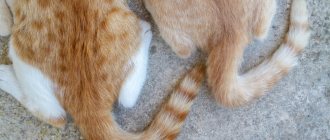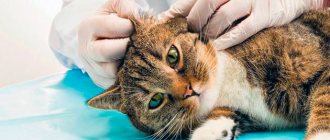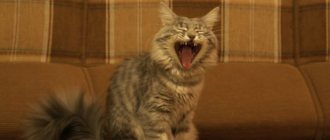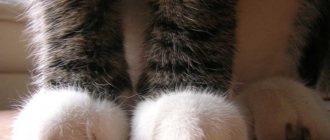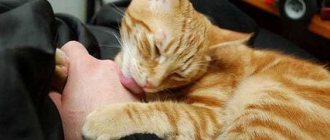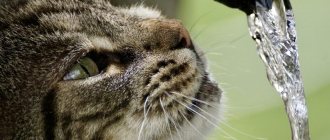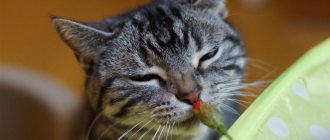Many owners wonder why their cats are shaking their tail. One of the main functions of this mobile and furry organ is communication, but it all depends on the specific situation.
Sometimes this behavior indicates health problems! Veterinarians recommend not to ignore frequent shaking and evaluate it together with the accompanying symptoms. Regardless of the true reason, this is a rather interesting experience that makes it easier to understand your pet.
Reason #1: tags
Whiskered pets leave their scent marks in order to attract the opposite sex and scare away competitors not only on horizontal surfaces, but also on vertical ones. To do this, they take a characteristic pose:
- maintain a straight body position and do not squat;
- point the tail straight up and spray a small stream of urine in the desired direction.
When marking territory, a slight tremor is explained by muscle tension that occurs involuntarily. Contrary to popular belief, not only males, but also females mark their territories. The only difference is that the latter do this less often, and their smell does not hit the nose so much.
“
In both cases, the situation is corrected by castration, but with one caveat. It does not eliminate the problem forever, but only reduces the likelihood of its occurrence.
Under certain circumstances, even castrati can mark. Most often this is explained by competition with a new pet who has not yet been neutered. The urine of these cats has a stronger odor and gives them a competitive advantage. Because of this, the spirit of rebellion awakens in the “old-timers”, and they again take up the old ways in order to prove their leadership qualities to the “newcomer”.
Attract attention
It is also possible that the animal has this behavior because it is jealous
the arrival of a new person in the house. Cats are very territorial and don't take change well, so if a child arrives or sees a new animal in your home, it's best to spend some time introducing yourself and letting your cat get used to this new presence.
In this sense, the animal will bite its tail only to attract attention
Although they are very independent, the truth is that they place great importance on love and want to feel loved. Therefore, if they feel that you are paying attention to other members, they may act in this peculiar way
Reason #2: passion for the hunt
Sharp twitching with swaying in different directions is typical for games with stationary objects and direct hunting of birds and rodents. In this way, the animal prepares for an attack and focuses on its prey.
Before the actual jump, you can see a peculiar wagging of the butt. This is necessary to distribute its own weight and calculate the flight path to the target.
IMPORTANT!
Discourage play with hands and feet. An older kitten can inflict very deep scratches without realizing the danger of its actions.
For homebody cats, chasing toy mice and teasing sticks replaces walks on the street. Thanks to regular active games, you can not only maintain your current weight, but also lose extra pounds. In the absence of contraindications, this method of losing weight is preferable, since reducing the usual portions leads to constant begging, theft, and waking up the owners in the middle of the night due to an acute feeling of hunger.
Reason #3: communication
The cat's tail is the main mood indicator used when communicating with humans and other animals. It conveys the emotions of its owner using the angle of inclination and the intensity of the wobble:
- raised high and slightly trembling at the base - happiness;
- lying in a relaxed position or wrapped around the paws - calmness;
- arching and fluffy - fear;
- sharply wriggling and hitting the sides - anger.
The listed positions are necessarily accompanied by additional gestures. Because of this, it is better to give the final assessment in total, not forgetting about the ears, whiskers, paws, eyes and sounds made.
When communicating with a person, cats can shake their tail in response to their name, without pointedly turning their head in his direction. Usually at such moments they are busy resting and do not plan to leave the heated place in the near future.
The cat's tail is shaking... in his sleep
You've probably seen your pet purring when he's taking a leisurely nap. Or maybe you've noticed that his body, including his whiskers, paws and tail are shaking. According to scientists, this may mean that your little predator is dreaming of something interesting, for example, chasing his favorite toy or... a mouse.
However, this is not the only possible reason. A moving tail when a cat appears to be dozing may mean that the cat is not sleeping at all, but is simply relaxing. However, he is still aware of what is happening around him. Most often this happens when the cat is resting near the window, and very interesting sounds are heard outside.
Source
Reason #4: joyful excitement
A slight shaking of the tail is also characteristic of joy. At such moments, he is proudly raised “pipe”, and the cat itself purrs contentedly, rubs against objects and arches its back. The reaction is observed when meeting the owner after work, while waiting for food and immediately after feeding. You need to act according to the situation:
- Greetings. Be sure to pet your pet and pick it up if he doesn’t mind.
- Waiting for food. Here, you are only required to serve on time, as your legs may suffer due to the long wait.
- End of feeding. At the end of the meal, the cat tries to thank you for the delicious lunch, but you can also praise or pet it in return. Regularly receiving approval from the owner normalizes appetite. This is especially important for those who eat less than their norm.
A similar gesture is used to invite people to play. Due to excitement, the cat may shift from paw to paw.
Some animals openly declare their intentions and bring toys to their owner. This behavior should be encouraged. If you are busy, give your pet at least a few minutes. This will strengthen your connection.
Diagnosis
By the way, how can you tell if your cat has abdominal cramps? Unfortunately, there are enough external signs of this: the animal may “scream” in a voice that is not its own, lie writhing in pain, and in milder cases, vomiting is observed. Severe profuse diarrhea cannot be ruled out. If something like this is observed when you try to go to the tray “in a small way,” then you are probably dealing with kidney spasms.
A biochemical and complete blood test is done, and a urine test is taken. In addition, those diagnostic techniques that allow you to examine the abdominal cavity and its organs “from the inside” are of great importance. These include radiography and ultrasound.
Reason #5: irritation and anger
Rhythmic movements in different directions, accompanied by frequent and loud knocking on the floor, mean irritation. To calm your cat, you will need to find out what is causing her anxiety. Most often, animals are disturbed by large crowds of people, strangers in their own home, prolonged absence of the owner, loud sounds and strong odors.
Try picking up and cuddling your cat, then direct her attention to her favorite toys or treats. Remember that not everyone enjoys communicating with other people, so in such cases, a mustachioed pet needs a house where it can hide and be alone.
When very irritated and angry, the tip of the tail bends into a hook. In this state, it is better not to touch the cat. Instead, you should look for the sources of her discontent and try to eliminate them.
In addition to the position of the tail, the following signs will help recognize aggression:
- pressing the ears to the skull;
- arching the back;
- dilated pupils;
- snorting and threatening hissing;
- fluffy fur along the spinal column;
- release of claws;
- demonstration of teeth.
It is recommended to leave a frightened pet alone.
The same applies to the reaction to affection. Braking during sleep is not a good idea. Try to respect your pet's personal space and only pick her up if she has given her consent.
Sometimes anger is caused by unattainable objects: birds and other animals outside the window. In this case, aggression is redirected to what is nearby. A single attack on your legs due to an unsuccessful pigeon hunt is prevented by throwing a blanket and urgently taking the aggressor to another room. If such attacks become more frequent, consult a veterinarian. Sedatives may be required to suppress aggression.
When an animal gets angry
When a cat starts to get angry, the tail immediately signals her displeasure. One of the characteristic movements in this case is a sharp movement of the tail from side to side. It becomes like a metronome needle. At such moments, we can talk not about wagging the cat's tail, but about quickly shifting it back and forth. This shows that the pet is extremely irritated and should not be touched.
We invite you to familiarize yourself with Karsil for dogs: how to give, instructions, dosage and reviews
The more furiously the cat wags its tail, the more caution the owner should exercise. Especially if the fur rises along it, and the pendulum movement is accompanied by the guttural sounds of a cat or a menacing hiss. If you don't leave the animal alone, it may attack. And these will not be ordinary scratches received when playing with a pet, but real wounds. Sometimes they lead to serious consequences for humans.
Thus, scientists have identified a disease that is called cat scratch disease or scientifically called felinosis. Being angry, a pet can deeply wound its owner and, through saliva, introduce an infection (Bartonella) into his blood. When the virus enters a person’s blood, intoxication of the body is possible, the symptoms of which are:
- enlarged lymph nodes;
- headache;
- feverish condition;
- lack of appetite;
- inflammation of the skin.
Another reason for sudden tail wagging may be the cat's readiness to hunt. While in nature, it patiently tracks down prey, and when it approaches, it takes some time to prepare to jump. At this time, the animal begins to flail its tail and actively wag it. When playing in an apartment, it may mistake a toy for a live mouse, or actually see some kind of “domestic” insect - a moth, a fly or a cockroach. Then the rapid wagging of the tail will be caused by the hunting instinct, and not by aggression or anger.
Reason #6: itching in the lower back
Sometimes owners are puzzled by why the cat twitches and shakes its tail, but does not mark. The simplest explanation for this behavior is severe itching. In both cases, there is indeed a slight contraction of the back, but if your pet has scabies, it is recommended to check for ectoparasites, that is, lice eaters, ticks and fleas.
In addition to itching, the main symptoms of infection include:
- constant scratching;
- hair loss, brittleness and dullness;
- partial or complete loss of appetite;
- the formation of ulcers and scabs at the site of scratched bites;
- moving black spots on the body;
- sleep disturbance;
- apathy or anxiety;
- reduction in body weight.
An animal with these symptoms should be seen by a veterinarian. Otherwise, complications may develop.
Another possible explanation for back contraction is rapid bowel movement. This is normal, but only if the pet goes to the toilet consistently.
Problems with bowel movements, accompanied by restlessness, poor appetite and plaintive meowing, may indicate constipation. The help of a veterinarian is also required here, since prolonged accumulation of feces can lead to intestinal rupture.
In addition to ectoparasites, a cat can be bitten by stinging insects: wasps or bees. The main danger of such bites is the presence of an allergic reaction to saliva. Regardless of the severity of the condition, the bitten pet should be taken to a veterinary clinic to prevent the development of anaphylactic shock. It can be recognized by the following signs:
- blue or pale mucous membranes;
- difficulty breathing;
- rapid increase in swelling;
- the appearance of severe vomiting or foam from the mouth;
- fainting.
A similar condition can be caused not only by wasp or bee saliva, but also by other allergens: pollen, household chemicals, tobacco smoke, and some foods.
When skin reactions occur, allergies can easily be confused with dermatitis, so do not self-medicate and be sure to consult a veterinarian if you have any alarming symptoms.
Why does a cat twitch the tip of its tail?
In some situations, the cat does not twitch its entire tail, but only the tip. Most often, this behavior is explained by preparation for an attack, doubts or research.
Reason #7: about to attack
It is quite easy to guess about an imminent attack if the pet is in plain sight. Before the actual jump, the tail actively flickers from side to side and trembles at the very tip.
Particular caution should be exercised if the attacker hits himself forcefully with his tail on the sides, arches his back and ruffles his fur, trying to appear larger than usual. This reaction is often accompanied by fear, and a frightened animal may inflict serious injuries in order to protect itself.
IMPORTANT!
Cats very rarely fight with each other. Unlike dogs, their wounds take a long time to heal, so receiving physical damage is not beneficial for them. They try to intimidate the enemy with an intimidating pose and loud howls.
Reason #8: doubts or investigates
Another explanation for why a cat twitches its tail may be doubt. Living side by side with humans, mustachioed pets adopt their habits. The simplest analogy is thoughtfully and unconsciously tapping your knuckles on a table or shaking your leg. Animals demonstrate their thoughts a little differently - with the help of a furry mood indicator.
If your pet randomly twirls and shakes its tail, slightly twitching the tip, be sure to take a closer look at other behavioral signs. The presence of doubts will be indicated by a complete lack of emotion.
At such moments, only one part of the body is active. The same applies to sounds. You can only notice concentration on some object or, conversely, a look into nowhere.
It is quite simple to get your pet out of the described state - you need to help him make a choice. The problem is that the reason for brooding is not always obvious. The simplest option is the proximity of a bag of food or another equally interesting item. If your pet is famous for its obedience, then without receiving approval, it will simply hypnotize the treats, not daring to sniff them closely.
How to understand your pet?
If you are patient and observant, it is easy to understand why cats wag their tail:
- 1. Peaceful mood. An indicator of friendliness and sympathy is a vertically raised tail. The pet often meets its owner in this position. Sometimes he demonstrates self-confidence in this way.
- 2. Playfulness. Smooth movements of the tail from side to side mean that the cat is in the mood to play. Rapid and sudden movements signal that the pet is getting very excited; at this moment you should not bother her, otherwise, instead of a toy, she will attack the arms or legs of the owner.
- 3. Curiosity. The tip of the tail quivers or twitches nervously. It shows excitement and increased attention. At this moment, the cat’s explorer instinct woke up, she learns something new, watches birds from the window, listens to unfamiliar sounds.
- 4. Peace. The tail is relaxed and curled around the body of a calmly sitting or lying cat. This means that she is in a great mood, she can be petted, and the pet will purr blissfully, expressing pleasure.
- 5. Anticipation of pleasure. A slight tremor signals the joyful anticipation of something the pet really likes. This happens when they are petted, and also when waiting for a favorite treat or toy.
- 6. Irritation. Protesters, sudden movements from side to side, express concern and irritation. This is a signal that the animal is angry and its claws will soon be used.
- 7. Threat, hostility. The cat randomly and often waves its tail in all directions, hitting the floor and its sides with it. Caution must be exercised; she is extremely hostile towards the person or object at which she directs her gaze.
- 8. Rage, anger. Characteristic stance - the back is arched, the fur is raised, the tail is fluffed, the cat hisses and makes characteristic sounds. You should not try to calm the animal at this moment. In a state of shock, it is capable of scratching or biting its owner.
- 9. Malaise, illness. Cats endure pain stoically and try to hide their weakness. Along with other obvious signs, the disease is indicated by the tense posture of the animal: hunched back, lowered head, paws and tail tucked under itself.
If an animal does not raise its tail and constantly tucks it under itself, this may indicate serious diseases of the spine. Immediate contact with a veterinarian is required.
The vast majority of people believe that our smaller brothers, namely cats, do not know how to express their feelings and moods. But this is not true at all. Cats' body language is very simple. The emotions of cats are very understandable and accessible to everyone.
To do this, you just have to watch carefully, and you will learn to distinguish, how to understand the cat's language. It is expressed primarily in the way the cat shakes. But let's take a closer look at how and why cats shake their tail.
